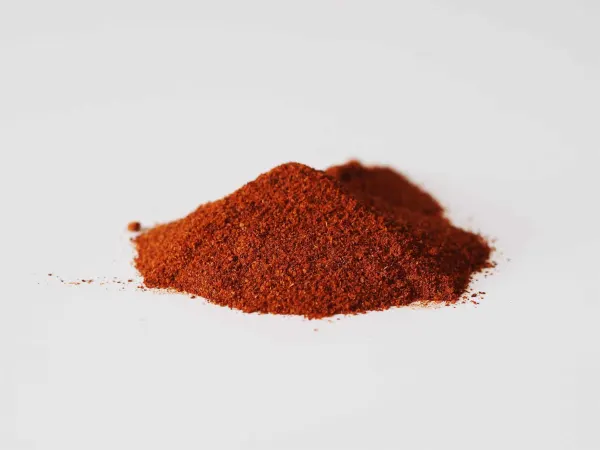Cayenne Pepper
Herb/Spice
Age Suggestion
6 months
Iron-Rich
No
Common Allergen
No

When can babies have cayenne pepper?
Cayenne pepper may be introduced as soon as baby is ready to start solids, which is generally around 6 months of age. Consider starting with a tiny amount of the powdered spice at first, as cayenne is typically quite hot.
Cayenne peppers originated in the Americas, and today, this spicy member of the pepper family grows in warm regions throughout the globe. The cayenne pepper is often dried and ground into a fine powder, which is used to add flavor and heat to egg dishes, hot sauces, seafood, and more.
Is cayenne pepper healthy for babies?
Yes. Cayenne pepper offers small amounts of a variety of vitamins, minerals, and fiber. In particular, cayenne contains vitamins A, C, E, and K. Together, these nutrients help aid digestion, vision, immunity, and bone health. They also contain a variety of carotenoids like beta carotene, lutein, and zeaxanthin, in addition to antioxidants and phytochemicals. Research also suggests that cayenne offers anti-inflammatory, antimicrobial, antioxidant, and anticancer properties.
Contrary to popular belief, babies can enjoy big flavors, including heat from ingredients like cayenne. Consider starting with small tastes and adjust the spice level based on the child’s responses and preferences. The goal is to follow the child’s lead and create positive experiences with new foods and flavors. Taste the dish before serving to baby, and if the dish seems too spicy, adjust the seasonings to mellow the flavor.
Avoid cayenne pepper capsules, extracts, and supplements for babies and toddlers, as research on their safety is limited and their use has been associated with stomach upset and skin irritation.
★Tip: Balance the heat by serving foods seasoned with cayenne alongside creamy and cooling foods like mashed avocado, plain yogurt, or age-appropriate milk, like breast milk, formula, or cow’s milk. Acidic or water-based foods and drinks can intensify the heat.
Is cayenne pepper a common allergen?
No. Allergies to cayenne ingestion are rare but have been reported. In those with cayenne pepper allergy, inhalation of the powder can also result in acute asthma symptoms. People who are allergic to latex or pollens (particularly birch or mugwort pollen) may also be allergic to peppers, such as cayenne, or experience Oral Allergy Syndrome (also known as pollen food allergy syndrome) upon ingestion. Oral Allergy Syndrome typically results in short-lived itching, tingling, or burning in the mouth and is unlikely to result in a dangerous reaction. Cooking cayenne pepper may help minimize and even eliminate the reaction.
Contact rashes are more frequently reported in sensitized individuals. In both children and adults, contact irritation reactions—such as temporary rashes, eye irritation, and digestive upset—to spicy peppers are frequently mistaken for allergic reactions. However, this is commonly due to the irritating qualities of capsaicin, the spicy component of peppers, in sensitive individuals, and is not typically a true allergic reaction.
Spicy foods like cayenne pepper may cause a harmless rash around the mouth while baby eats or may cause or worsen diaper rash. If baby has especially sensitive skin, consider applying a thin layer of barrier cream or ointment—such as pure petroleum jelly or a plant-based oil/wax balm—to baby’s face and bottom before serving foods prepared with cayenne to help prevent contact rashes.
As you would when introducing any new food, start by offering a small quantity for the first few servings. If there is no adverse reaction, gradually increase the quantity over future meals.
Is cayenne pepper a choking hazard for babies?
No. Ground cayenne pepper presents a low risk when safely prepared for a child’s age and developmental ability, though, in theory, an individual could choke on any food. To reduce the risk, prepare and serve cayenne pepper in an age-appropriate way. As always, make sure you create a safe eating environment and stay within an arm’s reach of baby during meals.
Learn the signs of choking and gagging and more about choking first aid in our free guides, Infant Rescue and Toddler Rescue.
Videos
How much food should I serve to baby?
When first getting started, offer a small amount and trust that baby knows how to show interest in wanting more by grunting, pointing, or reaching out. Keep in mind that most babies between 6 and 9 months of age do not consume much solid food at first. For babies between 10 and 12 months of age, work toward what a balanced adult meal would look like, just with smaller portions than what you might have. Follow the child’s lead: when baby indicates “more”, offer more food. When baby shows signs that they are finished, stop offering food.
What are some great first foods for babies?
There are many wonderful options. Look for foods that are easy for baby to feed to themselves, that are low in choking risk, and that offer nutrients babies need, such as iron. Some of our favorite first foods include steamed broccoli, oatmeal, and mango pits. See more ideas in our guide, 50 Fantastic First Foods.
How do you serve cayenne pepper to babies?
Every baby develops on their own timeline, and the suggestions on how to cut or prepare particular foods are generalizations for a broad audience.
6 months old +:
Let baby taste food seasoned with a tiny amount of powdered cayenne pepper, and adjust the spice level based on the child’s responses and preferences. The goal is to follow the child’s lead and create positive experiences with new foods and flavors. Note that cayenne and other spicy foods can cause coughing. You can balance the heat by serving spicy food alongside a creamy food like mashed avocado, plain yogurt, or a small drink of breast milk or formula.
12 months old +:
Continue to serve age-appropriate dishes seasoned with cayenne pepper and adjust the amount of seasoning to the child’s taste. Offer a creamy food like mashed avocado, plain yogurt, or a small drink of milk on the side to help the child balance the heat.
For more information on how to cut food for babies, visit our page on Food Sizes & Shapes.
Our Team
Written by
Expert Tips Delivered to Your Inbox
Sign up for weekly tips, recipes and more!
Copyright © 2024 • Solid Starts Inc




